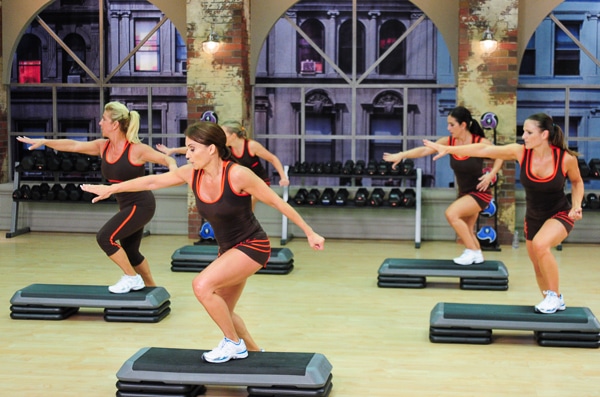
Who doesn’t want to burn more fat during exercise? It’s the muscle we want to hang on to. Unfortunately, too many people get stuck in a “cardio rut” where they do the same hour or more of steady-state cardio a few times a week. If you fall into this category, you’re getting cardiovascular benefits but your body quickly adapts to doing the same repetitive movements at the same intensity and burns less fat during your cardio sessions. Even long-distance runners who run 90 minutes or more a day can put on body fat if they never alter the intensity of their workouts.
Here’s the good news. According to researchers at the University of Guelph, doing a few sessions of high-intensity exercise each week can increase the amount of fat you burn during those steady-state cardio workouts. How so? Engaging in a little high-intensity activity turns on fat-burning mitochondrial enzymes that help you break down and use stored fat as energy. What could be better than that?
High-Intensity Interval Training and Its Effect on Fat-Burning
Researchers asked a group of healthy participants who regularly engaged in recreational exercise a few days a week, like walking, swimming and weight training, to do seven high-intensity training sessions over a two week period. During these sessions, they did four minutes of cycling at 90% of their V02 max followed by two minutes of rest for a total of four sessions. These sessions took about 25 minutes total and they did them 3 days a week for two weeks.
The results? After only 2 weeks of high-intensity training, the participants experienced significant improvements in their ability to break down and oxidize fat. In fact, their capacity to burn fat increased by almost 30%. These changes took place doing only 1.5 hours of high-intensity training a week. Plus, they experienced improvements after only 14 days of training. High-intensity training is time expedient!
What does this mean? If you’ve hit a fat loss standstill with your steady-state cardio routine, incorporating a few sessions of high-intensity interval training, like my soon to be released X10 DVD or my XTrain Tabatacise DVD into your routine each week can jump start your fat-burning engines. In this study, high-intensity interval training increased the capacity of mitochondria inside cells to use fat for fuel by increasing enzymes that oxidize fat.
Other Benefits of High-Intensity Exercise
There are other reasons to add high-intensity interval training to your exercise routine. High-intensity training boosts aerobic capacity, or V02 max, more than moderate-intensity training – and it’s a real timesaver. The beauty of high-intensity interval training is you can expose your body to higher total workload during a training session by allowing your body short periods of recovery time so you can up the intensity again during the next active interval.
Research shows that high-intensity training is more effective for improving V02 max (aerobic capacity) than moderate-intensity exercise. Most research shows it also improves aerobic capacity more quickly than moderate-intensity training. It’s ideal if you’ve reached a certain level of fitness through steady-state exercise and want to make further fitness gains.
There are other advantages as well. High-intensity exercise is superior for improving body composition, reducing belly fat including visceral abdominal fat, the kind that’s linked with a greater risk for heart disease and type 2-diabetes. When you do high-intensity exercise even for short periods of time, your body has to expend more energy to recover. This boosts your metabolic rate for hours afterward. This effect is known as excess post-exercise oxygen consumption or EPOC. You’ve probably heard this referred to as the “afterburn.” You get a greater afterburn with high-intensity exercise compared to exercise at a moderate intensity.
Then there’s the boredom factor. Doing the same thing at the same intensity for an hour or more can be mind-numbing. High-intensity intervals give you something new to focus on. Even if you continue to do steady-state cardio, adding a few high-intensity sessions weekly to your routine can help you further improve your aerobic capacity, increase your lactate threshold so you tire less quickly and increase your body’s capacity to burn fat when you’re doing steady-state exercise.
You may discover you prefer shorter, high-intensity workouts to long periods of moderate-intensity exercise. The disadvantage of long, steady-state cardio is it can lead to muscle breakdown and loss of the muscle tissue you worked so hard to get, especially if you don’t consume enough carbs and protein. You’ll still get superior cardiovascular and metabolic benefits with short, high-intensity interval workouts along with less muscle breakdown.
The Take-Home Message
If you haven’t tried high-intensity training, it could be just what you need to break through a plateau, lose weight and achieve a higher fitness level. You can do high-intensity training in a variety of ways, using most pieces of exercise equipment or no equipment at all. The key is to maximize the intensity during the active periods to the point where it’s difficult to say more than a word or two and then allow your body to recover until the next active interval. Why not try one of my high-intensity interval training DVDs to challenge your body, and mind, in a new way? It’s a time expedient, highly effective way to get fitter.
References:
Journal of Applied Physiology. April 2007. Vol. 102, No.4. pages 1439-1447.
Medicine & Science in Sports & Exercise, 665-671. (2007)
UVA Today. “High-Intensity Exercise Best for Improving Body Composition”
Am J Phys Med Rehabil. 2012 Nov;91(11):941-50.
Related Articles By Cathe:
These Are the Two Biggest Factors that Determine How Much of an Afterburn You Get
5 Cardio Mistakes That Are Killing Your Fitness Gains
High-Intensity Interval Training: How Intense Does It Have to Be?
High-Intensity Interval Training: How Long Should Your Active Intervals and Recovery Periods Be?
Related Cathe Friedrich Workout DVDs:
HiiT, Metabolic, and Interval Workout DVDs

